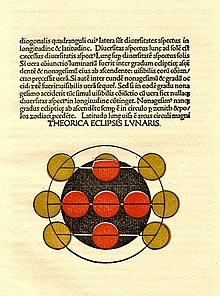Erhard Ratdolt

Erhard Ratdolt (* 1447 in Augsburg ; † before January 23, 1528 there ) was a German printer and publisher . He first worked in Venice (1476–1485), then in Augsburg (1486–1522).
Career
Ratdolt left Augsburg in 1474 and founded a printing company in Venice in 1476 , initially together with Bernhart Maler (Pictor) from Augsburg and Peter Loslein (or Loesslein) from Langenzenn . As evidenced by the colophons of their printing works, Loslein left the workshop before 1478, painter 1478, which was then continued by Ratdolt alone. A sales directory from 1484 lists 46 available titles, including a large-format Bible, missal books and breviary , works by Augustine and Thomas Aquinas , editions by Terence , Juvenal , Virgil , Martial , Sallust and Ovid as well as around a dozen legal, astronomical and mathematical ones and medical works.
At the beginning of 1486 Ratdolt returned to Augsburg; a typeface sheet dated April 1, 1486, with which he recommended himself to his customers, testifies to the foundation of a new printing house in his hometown, which in the following period mainly produced magnificent liturgical books, a total of around 50 to 60. The mathematician was from 1489 to 1491 , Astronomer and doctor Johannes Engel worked for Ratdolt as a proofreader and edited ephemeris . After 1522, no printed products from the Ratdolt workshop are known.

meaning
Ratdolt is considered to be one of the most important and innovative printers of the incunable era . He decorated his books as the first with printed trims in wood or metal cut with leaf, Bordüren- and tendrils that eventually the type area completely einrahmten, and thus created the typical Renaissance -Buchschmuck, still from the William Morris had influence. He was the first to use exclusively printed initials , the so-called litterae florentes , which were formed from leaves and flowers and which replaced the hand-painted initials that had been common up until then. He was also a pioneer of multi-color printing; In addition to black and red printing, he used gold as printing ink for the first time in the dedication of the Euclid edition to the Venetian Doge Giovanni Mocenigo , as well as in his later liturgical books, which are also characterized by their colored woodcuts, which were no longer colored by illuminators, but by where different colors were printed with several printing plates next to and on top of each other, which required a high degree of precision in production.
Ratdolt's typefaces are a beautiful Renaissance Antiqua , similar to that of Aldus Manutius , as well as a distinctive rotunda (round Gothic script). He was also one of the first to print in Greek.
Prints (selection)
- the calendar of Regiomontanus (1476 in Latin and Italian, 1478 in German), the first printed book with an ornate title page
- the Historia Romana of Appian of Alexandria in Latin translation from Greek (1477)
- the first printed edition of the Elements of Euclid (1482). This beautiful example of the classic shape of the Italian rotunda is a sumptuous incunabula lavishly decorated with almost five hundred ornamental woodcut borders. It is also the first book with printed mathematical illustrations, as Ratdolt points out with justified pride in his dedication.
- the Sphaericum opusculum by Johannes de Sacro Bosco 1482, which in the second edition of 1485 contained woodcuts printed in multiple colors for the first time
literature
- GR Redgrave: Erhard Ratdolt and his work at Venice . London, 1894
- Hans-Jörg Künast: Ratdolt, Erhard. In: New German Biography (NDB). Volume 21, Duncker & Humblot, Berlin 2003, ISBN 3-428-11202-4 , p. 168 f. ( Digitized version ).
- J. Braun: Ratdolt, Erhard . In: Allgemeine Deutsche Biographie (ADB). Volume 27, Duncker & Humblot, Leipzig 1888, pp. 341-343.
Web links
- Prints by Erhard Ratdolt in the complete catalog of the cradle prints
- Page about Ratdolt with numerous images of his prints
- Ratdolt, Erhard in the Typolexikon
- Ratdolts edition of the Flores astrologiae des Albumasar (Augsburg 1488) in the World Digital Library
Remarks
- ↑ In 1471 Peter Schöffer provided the incipit of Valerius Maximus with an initial printed in red and black, which was decorated by hand.
- ↑ 1476: GW M37455 ( digitized version ); 1478: GW M37475 ( digitized )
- ↑ GW 02290 ( digitized version )
- ↑ Wolfgang Beinert: Rotunda - half-Gothic script (script classification). In: typolexikon.de. 2017, accessed on June 4, 2020 (German).
- ↑ GW 09428 ( digitized version )
- ↑ Dedication 1482
- ↑ 1482: GW M14652 ( digitized copy showing some colored woodcuts); 1485: GW M14654 ( digitized , with some woodcuts printed in color)
| personal data | |
|---|---|
| SURNAME | Ratdolt, Erhard |
| BRIEF DESCRIPTION | German printer and publisher |
| DATE OF BIRTH | 1447 |
| PLACE OF BIRTH | augsburg |
| DATE OF DEATH | before January 22, 1528 |

